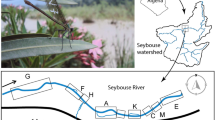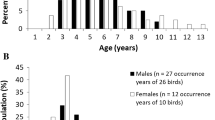Summary
The population structure of the endemic San Francisco Bay Area damselfly, Ischnura gemina, is examined using mark-recapture methods. Average daily movements, sex ratios, population size, maturation times, survivorship, and dispersion patterns, were recorded and calculated from two small (each less than one hectare) sites 150 m apart in Glen Canyon, San Francisco. Of 563 adults marked over 36 days, 412 (73%) were recaptured at least once. Average daily movements for males and females were less than 6 m, suggesting local movements. However, directional movements of 150 m were observed from one site to the other, indicating dispersal potential. One of the populations was a satellite composed entirely, of emigrating individuals from the other site; no larvae or teneral adults were found at the satellite area. Males were more aggregated than females at both sites. Both sexes were highly clumped at one site but were nearly randomly dispersed at the other site. Total population size for both sexes tended to be constant throughout the sampling period, at about 250. Adult population estimates showed more males were present than, females, but larval counts at one site indicated only a slight excess of males. Average life span estimates ranged from 6.5 days (females) to 23.3 days (males). One male lived at least 36 days. Maturation time for males was about 5–7 days, 7–10 days for females. A long life span and long flight season (March to November) are probably adaptations to the foggy San Francisco climate. All populations of I. gemina located to date are small, possibly originating from founders from nearby demes, and may be subject to different selection pressures. The dispersal potential of I. gemina may increase its chance of survival should small urban demes be threatened with destruction.
Similar content being viewed by others
References
Bick GH, Bick JC (1961) An adult population of Lestes disjunctus australis Walker (Odonata: Lestidae). Southw Nat 6:111–137
Bick GH, Bick JC (1963) Behavior and population structure of the damselfly, Enallagma civile (Hagen) (Odonata: Coenagrionidae). Southw Nat 8:57–84
Cannings RA, Doerksen GP (1979) Description of the larva of Ischnura erratica (Odonata: Coenagrinidae) with notes on the species in British Columbia. Canad Entomol 111:327–331
Cook LM, Brower PP, Croze HJ (1967), The accuracy of a population estimation from multiple recapture data. J Anim Ecol 36:57–60
Corbet PS (1952) An adult population study of Pyrrhosoma nymphula (Sulzer) (Odonata: Coenagrionidae). J Anim Ecol 21:206–222
Corbet PS (1962) A biology of dragonflies. Quadrangle Books Chicago p 247
Ehrlich PR (1961) Intrinsic barriers to dispersal in the checkerspot butterfly, Euphydryas editha. Science 134:108–109
Ehrlich PR (1965) The population biology of the butterfly, Euphydryas editha. II. The structure of the Jasper, Ridge colony. Evolution 19:327–336
Ehrlich PR, White RR, Singer MC, McKechnie SW, Gilbert LE (1975) Checkerspot butterflies: a historical perspective Science 188:221–228
Garrison RW (1978) A mark-recapture study of imaginal Enallagma cyathigerum (Charpentier) and Argia vivida Hagen (Zygoptera: Coenagrionidae). Odonatologica 7:223–236
Garrison RW (1979) Population dynamics and systematic of the damselfly genus Enallagma of the western United States (Odonata: Coenagrionidae). PhD thesis University of California, p 256
Grieve EG (1937) Studies on the biology of the damselfly Ischnura verticalis Say, with notes on certain parasites. Entomol Amer 17:121–153
Johnson C (1975) Polymorphism and natural selection in ischnuran damselflies. Evol Theory 1:81–90
Jolly GM (1965) Explicit estimates from capture-recapture data with both death and immigration-stochastic model. Biometrika 52:225–247
Kennedy CH (1917) Notes on the life history and ecology of the dragonflies (Odonata) of Central California and Nevada. Proc US Nat Mus 52:483–635
Lawton JH (1972) Sex, ratios in Odonata larvae, with particular reference to the Zygoptera. Odonatologica 1:209–219
Logan ER (1971) A comparative ecological and behavioral, study of two species of damselflies, Enallagma boreale (Selys) and Enallagma carunculatum Morse (Odonata: Coenagriidae). PhD thesis Washington St University p 82
Lord PM (1961) A study of the colour varieties of some damselflies. PhD thesis University of Wales
Manly BFJ (1971) Estimates of a marking effect with capture-recapture sampling J Appl Ecol 8:181–189
Manly BFJ, Parr MJ (1968) A new method of, estimating population size, survivorship, and birth rate from capture-recapture data. Trans Soc Br Entomol 18:81–89
Morisita M (1959) Measuring the dispersion of individuals and analysis of the distributional patterns. Mem Fac Sci Kyushu Univ 2:215–235
Parr MJ (1965) A population study of a colony of imaginal Ischnura elegans (Vander Linden) (Odonata: Coenagriidae) at Dale, Pembrokeshire Field Studies 2:237–282
Parr MJ (1973a) Ecological studies of Ischnura elegans (Vander Linden) (Zygoptera: Coenagrionidae). I. Age groups, emergence patterns and numbers. Odonatologica, 2:139–157
Parr MJ (1973b) Ecological studies of Ischnura elegans (Vander Linden) (Zygoptera: Coenagrionidae). II. Survivorship, local movements and dispersal. Odonatologica 2:159–174
Parr MJ (1976) Some aspects of the population ecology of the damselfly Enallagma cyathigerum (Charpentier) (Zygoptera: Coenagrionidae). Odonatologica 5:45–57
Parr MJ, Palmer M (1971) The sex ratios, mating frequencies and mating expectancies of three coenagriids (Odonata: Zygoptera) in northern England. Entomol Scand 2:191–204
Parr MJ, Parr M (1972) Survival rates, population density and predation in the damselfly, Ischnura elegans (Vander Linden) (Zygoptera: Coenagrionidae). Odonatologica, 1:137–141
Parr MJ, Parr M (1979) Some observations on Ceriagrion tenellum (de Villers) in southern England (Zygoptera: Coenagrionidae). Odonatologica 8:171–194
Scott JA (1973), Convergence of population biology and adult behavior in two sympatric butterflies, Neominois ridingsii (Papilionoidea: Nymphalidae) and Amblyscirtes simius (Hesperioidea: Hesperiidae). J Animal Ecol 42:663–672
Scott JA (1974) Adult behavior and population biology of two skippers (Hesperiidae) mating in contrasting topographic sites. J Research Lepidoptera 12:181–196
Scott JA (1975) Flight patterns among eleven species of diurnal Lepidoptera. Ecology 56:1367–1377
Sokal RR, Rohlf FJ (1969) Biometry the principles and practice, of statistics in biological research, WH Freeman and Co San Francisco p 776
Van Noordwijk M (1978) A mark-recapture study of coexisting zygopteran populations. Odonatologica 7:353–374
Author information
Authors and Affiliations
Rights and permissions
About this article
Cite this article
Garrison, R.W., Hafernik, J.E. Population structure of the rare damselfly, Ischnura gemina (Kennedy) (Odonata: Coenagrionidae). Oecologia 48, 377–384 (1981). https://doi.org/10.1007/BF00346498
Received:
Issue Date:
DOI: https://doi.org/10.1007/BF00346498




